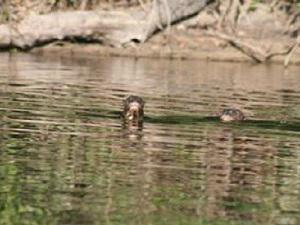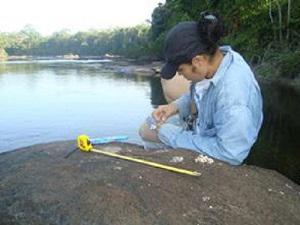Fernanda Michalski
Other projects
29 Sep 2008
Use of Riparian Corridors by Otters in a Highly Fragmented Amazonian Landscape – A Preliminary Assessment
The aim of the project is to obtain baseline data to understand conflicts between otters and fishermen in a tropical conservation unit and its surroundings in the Brazilian Amazon.

The rise in the extent of protected areas is a success for biodiversity conservation (Stockstad 2010). Currently, almost 37% of the Brazilian Amazon is protected (Azevedo-Ramos et al. 2006). The benefit of such legal protection for biodiversity conservation is well known yet the contribution of sustainable-use areas towards socio-economic development remains poorly understood. The local success of protected areas for biodiversity conservation depends on integration with local communities.

The Floresta Nacional do Amapá (FLONA) is a 412,000-hectare sustainable-use reserve in Amapá state. It is located at the confluence of the Araguari and Falsino rivers and local families earn their livelihood along the river margins. Due to their picivorous diet Giant otters are widely perceived as competitors by fisherman across the Amazon basin. Giant otter populations were decimated by the fur trade, with 1000–3000 pelts exported annually from the Brazilian Amazon during the 1950–60’s (Smith 1980). Despite legal protection and localised reports of population recoveries (Uscamaita & Bodmer 2010) it is estimated that habitat loss will lead to a 50% population reduction over the next 20 years (Duplaix et al. 2008).
Fish are an important protein source for local communities surrounding FLONA. The proximity of local communities and Giant-otters around FLONA is generating conflicts which could undermine both the mission of the protected area and the conservation of this endangered species. Developing effective mitigation strategies for human-otter conflicts is necessary to prevent local communities in the remaining Giant otter strongholds from adopting lethal control in retaliation for perceived and/or real losses.
The aims of the project are: 1) quantify the overlap (species and size) between Giant otter diet and fish harvested by local fisherman in and around FLONA, 2) quantify the Giant otter population size and their spatial distribution in and around FLONA, 3) determine the attitudes of local landowners towards Giant otters, and 4) initiate outreach activities.
We hope this is a first step towards the establishment of a positive case study for the integration of biodiversity conservation and socio-economic development in the Brazilian Amazon.
.